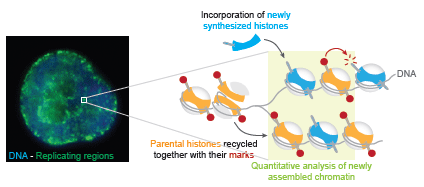Understanding cell memory
Histones are proteins that are tightly bound to the genetic material, our DNA. Histones carry information that determines cell type and cell properties, collectively termed cell identity, by controlling which genes are turned off and on. Understanding how information in histones is inherited every time our cells divide, is fundamental to explain how cell identity is remembered and daughter cells obtain the correct properties. Researchers from BRIC, University of Copenhagen, now reveal how histone-based information is copied when cells divide. The results are important for the understanding of human biology and disease. The results are published in the journal Genes and Development.
Prior to each cell division, the DNA molecule is duplicated and transmitted to the two daughter cells. The process of duplicating the DNA molecule is not easy given that it is packed around histones. In addition, histones carry information in chemical modifications, which also need to be transmitted to the daughter cells. The duplication of the DNA molecule is well understood. Yet, how histone modifications are inherited by the daughter cells remained unclear.
Associate professor Anja Groth’s lab have developed a new technology that enables isolation and analysis of histones on newly duplicated DNA and following their chemical modification across several cell generations.
-This work uncovers the fundamental principles for how histone-based information is copied and transferred to daughter cells and thus gives us crucial insights into how cells remember their identity ”, says Anja Groth.
Histone modifications are restored by two distinct mechanisms
The researchers have developed a technology, called nascent chromatin capture (NCC) that can directly track proteins on newly duplicated DNA. They have used this technology to follow histone modifications when cells divide.

-By using NCC in combination with a technique that identifies proteins and their modifications (quantitative mass spectrometry), we could track how histone modifications are duplicated and transferred to daughter cells. Interestingly, we found that two different copying mechanisms was used depending on the exact chemical modifications”, explains Constance Alabert, who conducted the experiments as part of her postdoctoral research.
The study also provides a platform to address many other fundamental questions regarding cellular memory. The researchers now aim to study how the duplication of histone modifications contributes to central processes in development of the organism and in diseases. They are particularly interested in understanding the implications for cell specialization during development, the loss of cell identity in cancer cells and the ability of cells to 'change identity' to provide stem cells for biomedical use.
-It has become clear that our DNA alone cannot explain the complexity of life, but that additional information (such as epigenetic information in histones) play a major role. This is a field in rapid development with great biomedical importance, and in addition to provide basic knowledge of cell memory, our study is also important for the understanding of complex diseases such as cancer, as well as for exploiting epigenetic mechanisms in treatment”, concludes Anja Groth.
The research was supported by grants from the European Research Council (Starting Grant, no. 281,765), the Danish National Research Foundation to the Center for Epigenetics (DNRF82), the Danish Cancer Society, Human Frontiers Science Program and the Danish Medical Research Council.
Contact
Associate Professor Anja Groth
BRIC and Center for Epigenetics
Phone: +45 35325538
E-mail: anja.groth@bric.ku.dk
Postdoc Constance Alabert
BRIC and Center for Epigenetics
Phone: +45 35335016
E-mail: constance.alabert@bric.ku.dk
Original paper
Two distinct modes for propagation of histone PTMs across the cell cycle. C. Alabert, T.K. Barth, N. Reverón-Gómez, S. Sidoli, A. Schmidt, O.N. Jensen, A. Imhof and A. Groth. Genes and Development, March 2015.
